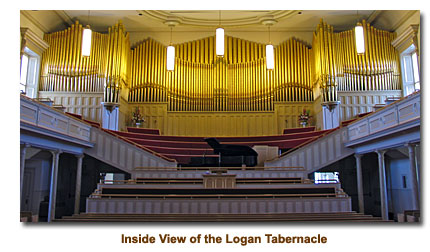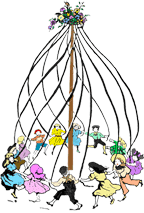Construction of the Tabernacle
As the number of wards in Logan City increased and more settlements in the Valley were established, it was decided to build a Tabernacle or Stake house on the square where the wards could meet conjointly and the Cache Valley Stake could hold its conferences.
Work for the construction of the building was commenced as early as the winter of 1865. The face of the mountain between Logan and Green Canyons was covered with a thick growth of good red pine and here the logs were cut and slid down the mountain side. A foundation was dug and built to the level of the ground, but as Bishop William B. Preston and others were called on missions to Europe, further work on the building was discontinued. A large bowery was built on the southeast corner of the square where the wards met conjointly and conferences of the Cache Valley Stake were held during the summer months for several years. Some of the logs cut for the tabernacle were used in the building of the bowery.
After the return of Bishop Preston from his mission, it was decided that the plans for the tabernacle were inadequate and the foundation which had already been put in and consisted principally of cobble stones, was not suitable for the proposed building. The foundation was therefore taken out and the rock was used to help complete the rock wall around the tithing block.
A much larger building was planned and a new foundation was dug. Work commenced in earnest. The settlements outside of Logan, as well as the Logan wards, were asked to contribute money, labor or materials as it was to be a stake building. A good quarry site was located in Green Canyon from which large slabs of red stone and blue or lime stone were quarried. The lime stone was suitable in every way for building purposes, as it could be chiseled easily. The red rock was used for footings and in the foundation and other parts of the building. Most of the rock for the construction of the Temple also came from this quarry. The white rock which was used for the corners and trimmings was located near Franklin and was quarried under the supervision of Mr. Ralph Smith. It was a fine building stone and was used to good effect in many of the early homes, especially in Franklin, Idaho. Mr. Robert Crookston was one of the main workers in the quarries.
It became necessary to locate more and better timber so a thick grove of fine red pine was opened up in the Tabernacle Hollow near Wood Camp. The timber was cut and floated down the river to a point near the present Eight Ward meeting house. Here the logs were hauled to the Card sawmill and sawed into the proper dimensions. A large grove of white pine was located in what is known as the White Pine Hallow, or Valley, and Mr. Maughan built a sawmill near the Red Banks and all the white pine lumber used in the construction of the tabernacle and the temple as well, was sawed here. Later the mill was sold and became the Crowther mill. The red pine for the temple was mostly sawed at a mill erected in what is known as Temple Hollow or on the Temple Fork Creek. Mr. David Lamereaux was superintendent of construction and Joseph Schvaneveldt and James Fogg were the sawers. Thousand of feet of lumber and ties were sawed at this mill and for those days it was very efficient.
 Lime kilns were built near the present pipeline of the Utah Power and Light Company and were in charge of Mr. Nathaniel Haws. All the lime for the tabernacle and the temple was secured from these kilns.
Lime kilns were built near the present pipeline of the Utah Power and Light Company and were in charge of Mr. Nathaniel Haws. All the lime for the tabernacle and the temple was secured from these kilns.
Bishop Skanchy was superintendent of construction for the Tabernacle, Mr. James Quayle of Logan was the master mechanic and Mr. Joseph Hill of Smithfield was the master mason. Mr. Christian Garff assisted in making the benches and much of the machine work was done at the Garff and Lundberg planing mill.
The basement of the tabernacle was completed first and all the joint ward meetings and conferences of the stake were held in it until the building was completed about the year 1877 or 1878.
The tabernacle along with temple, will stand as a monument of much hard labor and sacrifice of the early settlers. It was a double burden because the temple was started before the tabernacle was finished and then all the wards and settlements were striving to get their own meeting houses and public buildings. It was before the practical use of cement and nearly all the materials and furnishings had to be obtained or manufactured here.
